shop
News
Urban Digital Color Recent Projects Spring 2015
May 02, 2015
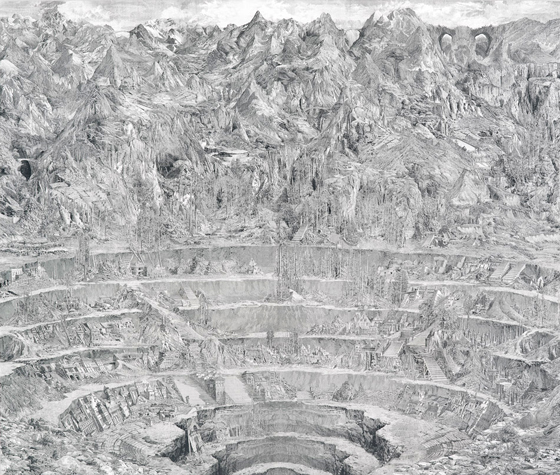
Over the past year we've been working with Bay Area photographer Hal Fischer on reprinting of the complete portfolio of Gay Semiotics and the billboard that was produced in conjunction with the original exhibition in 1977. Next week the reproduction of the original billboard will be on display at Pearl and Market Street in the Castro. Be sure to scan the Castro skyline and check out the full exhibition of Gay Semiotics at Ratio 3 on May 22nd. Also there's a great interview between Hal Fischer and Julia Byran-Wilson in the Spring 2015 edition of Aperture.
http://www.aperture.org/blog/gay-semiotics-revisited/
We've had the pleasure of working with photographer Lucy Gray scanning and printing her body of work, Balancing Acts. In March, Princeton Architectural Press published her monograph of the same title. Gray will also be exhibiting Balancing Acts at the Harvey Milk Photo Center May 9th-June 7th. The opening reception is May 9th 1pm-4pm and from 2pm-4pm she will be on hand signing copies of her book!
https://www.papress.com/html/book.details.page.tpl?isbn=9781616892548
This spring we published Dean Byington by Dean Byington. Byington has worked with UDC for many years, this publication gives insight into the artist's history, source materials and methods. It also includes an original short story and poem by the acclaimed author and essayist Rick Moody.
http://www.gallery16.com/index.php?page=books&book=byington
Dean Byington will be exhibiting The New City at Leslie Tonkonow Gallery in New York City, May 16th-June 10th!
Alex Zecca : New Work
March 20, 2015
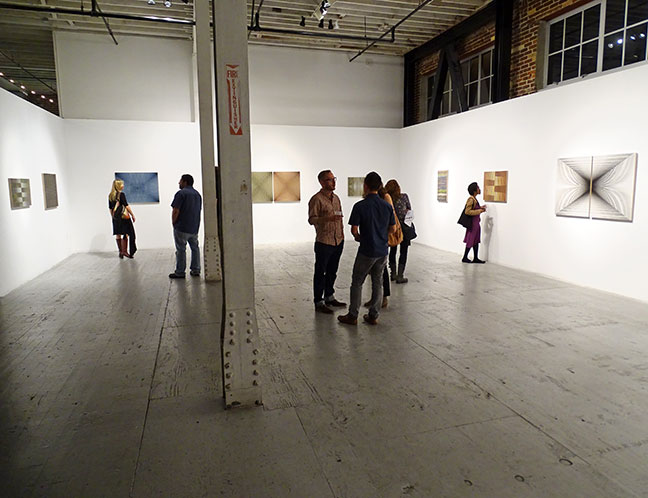
Alex Zecca: New Work
March 20 - May 15, 2015
Gallery 16 is pleased to present its sixth solo exhibition with artist Alex Zecca.
The new drawings and sculptures of Zecca’s continue the artist’s obsessive and precise methodology. They are time-intensive, process-oriented works made through a laborious accumulation of steady inked lines. Each vibrant abstraction is the literal record of thousands of painstakingly rendered marks, made with only a pen and straight edge.
Art critic Kenneth Baker wrote, “Alex Zecca has long worked with such methodical consistency that I go to each new exhibition of his expecting to see more of the same. But he has not yet failed to surprise. You move around certain of Zecca’s new works on paper expecting flickers of iridescence, so keenly do they recall the powdery luminosity of a butterfly wing or exotic plumage.”
San Francisco artist Alex Zecca’s precise, hand-drawn works marry a sense of the scientific with the art of craft. While process is at the center of his work, his thousands of steady, painstakingly inking lines ultimately reveal extravagant optical Moire patterns. Each piece is produced with a preordained number of lines and colors, melding the conceptual and the handmade.
After studying at CCA, the San Francisco Art Institute and in Italy, Zecca has gone on to show his work in numerous solo exhibitions at San Francisco’s Gallery 16, and has been included alongside other masters of pattern like Yayoi Kusama and Ross Bleckner in the Crocker Art Museum’s exhibition Approaching Infinity: The Richard Green Collection of Meticulous Abstraction.
“My work’s central focus continues to be the result of cumulative action and precise structure. Each drawing implements a unique algorithm. The intersecting lines of which create organic Moire forms.” -AZ
Interview with Charles Linder in SFAQ, Issue 19 // By Paul Karlstrom
February 18, 2015

CHARLES LINDER: IN CONVERSATION WITH PAUL KARLSTROM
SFAQ_Issue-19_C Linder Interview
A wonderful tribute to Rex Ray from KQED
February 11, 2015
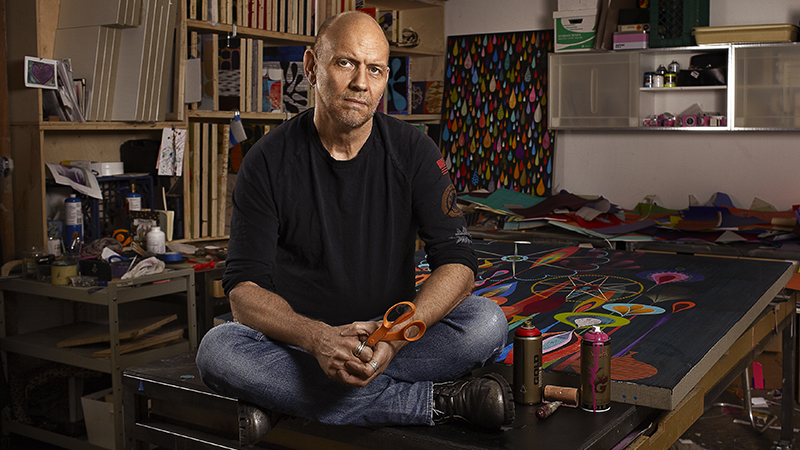
Finding Beauty Along the Edges: Remembering Rex Ray (1956–2015)
By Christian L. Frock
Published February 10, 2015
News of San Francisco artist and designer Rex Ray’s death rippled out over the ether Monday afternoon, with many friends and admirers expressing sorrow on social media. Author Rebecca Solnit posted on Facebook about meeting Ray in 1989, and in noting that he designed her first book, wrote, “He made ‘high’ art as well as design and then they merged into something gorgeous and extravagant and joyous and very colorful.” Shortly thereafter a warm tribute to Ray went up on David Bowie’s website, coinciding with a heartfelt post by Griff Williams, owner of Gallery 16 and the artist’s gallerist of nearly 20 years. That Ray’s work so fluidly traverses art and design is a testament to his inestimable talents; that his work is so widely embraced is a testament to him.
I didn’t know Ray personally, but I would know his work from across the room. I first encountered his collages in 2002 at ModernBook/Gallery494, a gallery-cum-bookstore then located in Palo Alto that featured small exhibitions of highly crafted artworks and art books with a strong design aesthetic. Small works on panel by Ray lined the walls; their lush resin coated surfaces and exquisite color palettes drew me in off the street like a bee to honey, and I wasn’t the only one. I worked at a gallery two doors down and everyone who walked in asked me if I’d seen Ray’s show. The work held broad appeal in Palo Alto, to be sure, where Joseph Eichler’s mid-century modern homes are symbols of good taste and timeless design. Ray’s intricate cut paper collages have always been simultaneously retro and contemporary.
His finely detailed images are often evocative of foliage and often present a bejeweled dreamscape, firmly entrenched in loveliness. Ferris wheels, starbursts and delicate chains make appearances, as do organic forms composed of tear-shaped cut paper petals. Ray’s color combinations are somehow optimistic, or maybe it was his implementation of cutaway shapes, giving practical beauty to the cuttings others might have thrown away. But not Ray — in his work negative space is as essential as positive space, and it speaks volumes about his eye for detail. Coming upon his work now, I look for the “edge events,” small details that give powerful visual impact to the edges of his work. The eye could languish in the center of his compositions quite happily, but Ray also knew to celebrate their boundaries.
Even if the work hinged somehow on being “too beautiful” for some people — we all know the type — his rock ‘n’ roll side could engage anyone. By day, of course, Ray was a graphic designer with a penchant for music. He did corporate gigs and commercial projects for the likes of Apple and Levi’s, including a construction barrier that may have one-upped a lot of public art on display at the time. Early on, he designed posters and T-shirts for ACT UP, and later he created concert posters for just about everyone, including Florence and the Machine, Radiohead, Kanye West, Rihanna, The Rolling Stones, Bryan Adams, Beck, R. E. M., and Paul McCartney, among many others.
Beyond all of that, he experimented with putting his work on everything from posters to note cards, mugs to iPad covers, jigsaw puzzles to decorative trays, and beyond. He illustrated children’s books and calendars — and once even wrapped a Smartcar in his designs for charity. The beauty of covering all the bases, the so-called high and low, is that the work belongs everywhere, from the museum walls to the gift shop to the street. I vividly recall seeing SFMOMA’s gift shop window tricked out a few years ago with a display of Ray’s wares. He also had many museum shows, of course, and reproductions, as fun as they are, are never as amazing as the work is in person, but frankly it was his ability and his willingness to experiment in so many arenas that was a huge part of his appeal.
Purists have debated whether Ray’s art was really design or whether his design was really art, but these boring distinctions hardly mattered — really, who cares? He kept working, prolifically imprinting his legacy everywhere. Gone too soon, at just age 58 after years of battling lymphoma, he left a tremendous array of art and design to populate the void. The work that remains, all of it, reminds us to look for art high and low — and to find beauty along the edges however, wherever we can.
Work by Rex Ray is currently featured in the traveling group exhibition,Beauty Reigns: A Baroque Sensibility in Recent Painting, which is organized by René Paul Barilleaux, Chief Curator, for San Antonio’s McNay Art Museum. A public memorial for Ray is scheduled for March 12, 6pm, at Gallery 16. For more information, see Gallery 16’s site.
None of Us Is Doing This Right: Improvising in the Art World // A conversation between Tucker Nichols and Griff Williams
February 11, 2015
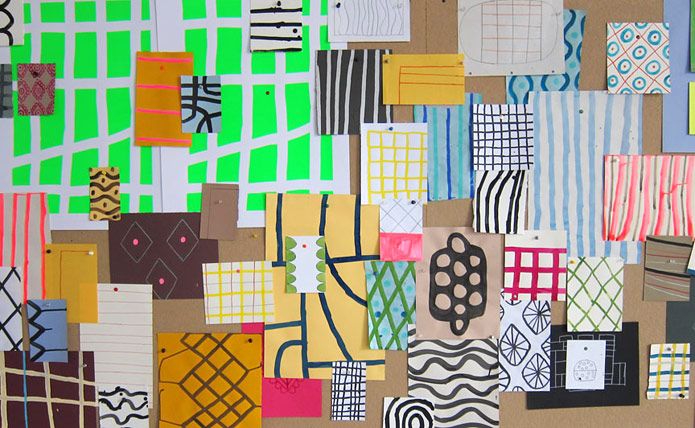
THURSDAY, FEBRUARY 12, 6-8 PM @ GALLERY 16.
Please join us! RSVP.
How did we think a life in the arts was going to look? And how is it actually now that we’re doing it? How far does following your gut really take you? What do we do with all of the unspoken rulesof finding success? And, of course, should you put prices on the checklist or not?
Please join Tucker and Griff as they continue their ongoing conversation about navigating a life in the arts. But this time they’ll do it in front of an audience. They will probably field questions and maybe ask them of people in the audience too.
Please come have a drink or two and listen to these two dig a conversational hole from which they can’t possibly emerge.
This talk will take place amidst Tucker Nichols’ exhibition, on view at Gallery 16 until March 6th. For this exhibition Tucker presents a show of new paintings, his fifth solo exhibition with the gallery. The exhibition is made up of 40 paintings and framed drawings, mostly of vases with flowers, a long-favored subject for the artist. “Flowers are a near perfect subject for a painting,” Nichols says. “They offer a bit of content but they can really look like anything. They’ve also been used as a stand in for inexpressible ideas since humans first started talking.” The new paintings explore more abstracted forms as well, in some cases resembling smokestacks or disheveled cakes.
Earlier this year, Nichols began making small flower paintings on paper to send by mail to sick friends. These evolved into a permanent commission of 40 framed works at the new UCSF Hospital at Mission Bay opening in February. This fall he began making the larger paintings for this exhibition “for people too busy to take care of real plants.”
Unlike previous installations in which Nichols combined many works into larger pieces, this show is composed exclusively of stand-alone paintings and drawings. “I like playing with context and location in installations, but it’s good to make things that can live on their own too,” Nichols says. “These paintings don’t need anything, not even water.”
REX RAY 1956-2015
February 09, 2015
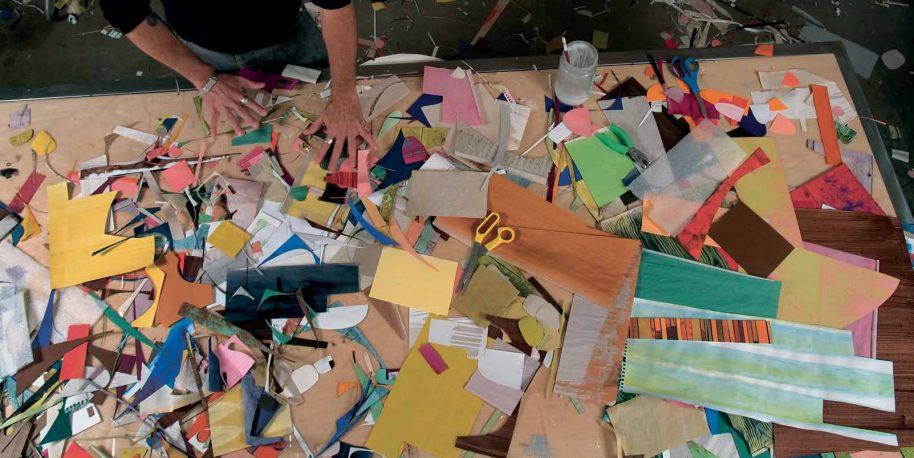
It is with great sadness and a wounded heart that I write with the news of Rex Ray's death. He passed away last night after a long struggle at the age of 59. I’m honored to say he was my friend of nearly 25 years.
At a very early age, Rex knew that art-making was his passion. And for the
rest of his life he worked everyday at fine tuning his craft. Work was
important to Rex--The work of making art, the work of relying on his
imagination and accepting the consequences. He invented a way of working
as an artist that was singularly his own. How many of us can say that? How
many of us can ignore our critics and truly follow our own particular
sensibility? Rex did that everyday. Not without self doubt, he had that for sure.
Not without failure, he was frank about that as well. But, he lived his life and made his work with grace.
He loved music. Did he! He studied at the San Francisco Art Institute and
Tower Records. He was an avid collector of vinyl records with a wide open
mind and a curious ear. His collection was the envy of his friends and the
collection itself was frequently incorporated into his graphic artwork.
No pussyfooting!
His epic catalog of rock posters is enough to cement his creative
reputation. His tour posters and album art is a who’s who of rock royalty
including David Bowie, The Stones, Radiohead, Beck, Robert Plant, REM and many more.
But, that was his day job. His passion was a lifelong studio art practice. Making
artwork was the unerring focus of his life. His exuberant canvases were so
singularly his, made with a collage technique developed through trial and
error over decades of constant work with the goal of describing his own
particular sense of beauty. It just so happens that many thousands of
others found that it was their sense of beauty as well.
I am stunned by the global outpouring of those touched by his work. He
was a true populist art star. Rex exhibited his work in the second show I
organized after founding Gallery 16. For the next 20 years I’ve
marveled at the way he crafted a life in the arts utterly of his own
making. He was often opposed to the dominant trends of the art world, but
was always aware of them. His success was not aided by powers in the art
world, collectors or curators. His success was the result of a populist
outpouring of people who coveted his work. While all artists borrow and
steal from those who came before, Rex did so while developing a style that
was uniquely his own. A style that has become so routinely imitated. The
artist David Robbins proclaimed “ Make whatever you like and accept the
consequences without complaint. Don’t ask curators. Don’t ask the
marketplace. Don’t ask New York. Don’t ask Hollywood. Insist on complete
access to your own imagination.” This could have been Rex’s mantra.
I loved Rex. His bright smile, his dark humor, his effortless cool, his
eagerness to say YES! Rex was a deeply driven creative spirit and an
extremely humble man. He was generous to others, self deprecating and
fiercely loyal.
So, in Rex’s wake lets look within ourselves, within each other, and
embolden those gifts that make each of us distinct: not wealth or fame,
intellect or pedigree, but the extraordinary beauty of the human heart.
-Griff Williams
ArtLTD artist profile: Tucker Nichols (January 2105)
January 24, 2015
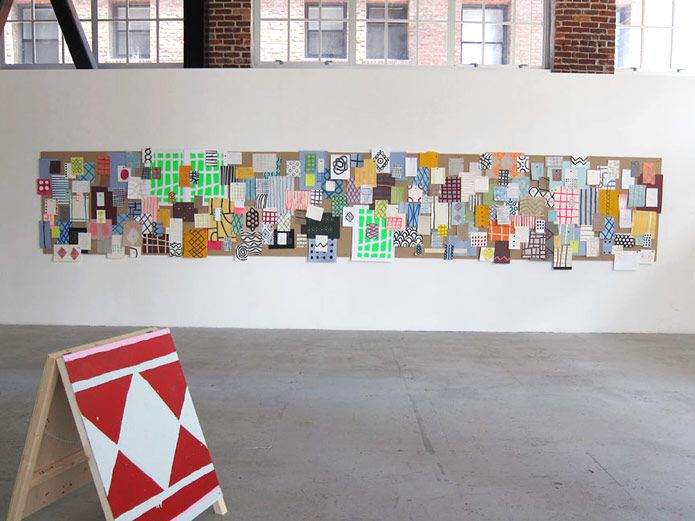
Art LTD Magazine
artist profile: Tucker Nichols
By Barbara Morris
With the work of artist Tucker Nichols, the whole is invariably far greater than the sum of its parts. Nichols’ studio is a cheerful orderly space, his small vibrant drawings and paintings dot the walls—grids and stripes in red, blue, violet, green or DayGlo pink, or simple calligraphic line drawings of sticks, plants and vases. “Art is such a beautiful language of complexity,” says Nichols. Given to creating multitudes of small works on paper each day, his work is as much about the “editing” process as it is the act of making them.
Born in Boston, he became interested in Asian art history as an undergraduate at Brown University. In a survey class, he was struck by the ability of a brushstroke from an ancient Chinese painting to reach across the years and convey an intense feeling: “I’ve been following that ever since.” He received an undergraduate degree in Chinese Art History and moved to Taiwan, immersing himself in a community of lively and innovative artists and musicians.
Returning to the US, he obtained a position at the Asia Society in Manhattan. “It was a place that was really understaffed, but with a very ambitious director and program,” he recalls, “so it was ideal really for me to do things for which I was not actually trained for or entitled, really, to do, like exhibition design... handling a lot of priceless ceramics and scrolls.” Deciding that the kind of creative life he wanted to pursue—perhaps, he thought, as a museum director—would be best served by further study of art history, he embarked on a master’s program at Yale. “Pretty much as soon as I got there,” he revealed, “I knew that I had taken a wrong step.” He simultaneously began having serious health problems, diagnosed as Crohn’s disease. Nichols managed to complete his MA requirements in one year. Nichols enjoyed several summers during college spent with friends in the San Francisco Bay Area, moving to the West Coast in 1989. During the dotcom boom, he worked for an internet start-up with a “somewhat ill-conceived plan to sell fine art on line.” When that ended, and with continuing health problems, Nichols came to the realization that he did not want to waste his precious time and energy in a corporate job, and started to reinvent himself as an artist.
He first began showing with SF’s Lincart gallery, where director Charles Linder became a very important figure in his early career. Moving into an empty studio space near Linder’s, Nichols realized that the space had been vacated by a failed start-up. “It looked like they’d left in kind of a hurry,” he laughs. He began drawing directly on the walls, creating a hypothetical “brainstorming session gone awry” flow chart, as though he were the last man standing at the company. This work has continued to feed into other conceptual projects and commissions, such as a recent one for Facebook.
Griff Williams’ Gallery 16 has been showing the artist since 2009. “I found in Griff the perfect collaborator, he is nothing if not open to artists showing things they don’t quite understand yet.” Nichols’ last exhibition there, “Stockhouse,” mounted in conjunction with a theatrical set piece commissioned by the SFMOMA, included small works on paper in DayGlo pinks, black, lemon yellow or bright greens with simple, child-like designs and patterns, all carefully arranged into wall-size compositions. The result was to ultimately convey a great sense of intention that becomes, in some way, profound.
Nichols’ upcoming show at Gallery 16 in February will tie into the concept of how objects convey meaning. Nichols expects that it will evolve from a recent commission of 40 works for the children’s infusion ward at UCSF Hospital at Mission Bay. “I’m just completing the first project that really unites my health world with my art world.” Nichols himself regularly visits an infusion center to keep his Crohn’s disease in check. In one work, a simple outline of a vase on an irregularly cut piece of paper sprouts wayward lines, these stems capped with bold circles in red-orange that convey the essence of blossoms, perhaps poppies. “In a hospital environment you see a lot of flowers in vases in people’s rooms,” Nichols says. “It’s an attempt to communicate… something beyond words.”
Tucker Nichols’ new solo show will be on view at Gallery 16, in San Francisco. From January 26 – March 6, 2015. www.gallery16.com
Published January 2015
Tucker Nichols - ArtLTD 2015
Tucker Nichols: New Paintings feature in SF Gate
January 24, 2015
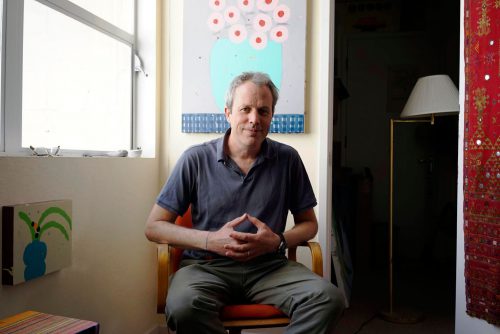
Tucker Nichols 'New Paintings’ exhibit in full bloom
Published Wednesday, January 21, 2015
By Kimberly Chun
Tucker Nichols’ worlds are colliding these days, in the most positive way possible. Since the Bay Area artist was diagnosed in 1998 with Crohn’s disease (a type of inflammatory bowel disease), now in remission, he has become well acquainted with the halls of UCSF, receiving a drug infusion every eight weeks. But his next big project, after his Gallery 16 exhibit, sees his art and health spheres aligned: It’s a commission for the UCSF Mission Bay Children’s Infusion Center of 40 framed flowers in vases that hover between abstraction and calligraphy.
“What I like about flowers and vases is they’ve been a vehicle for people to convey inexpressible ideas,” says Nichols, 44. “It starts with something on display and then drifts.” Uncommon blooms, unlike the ones that usually crop up in hospitals, these will pop up in unorthodox spots throughout the waiting areas. We spoke to Nichols from his home not far from his San Raphael studio.
Q: Has Crohn’s disease affected the work?
A: In a way, it certainly has. Dealing with Crohn’s disease has pushed me to dedicate myself to a career as an artist. I was always drawing and painting, but only when I was saddled with the disease did I realize I only have so much time.
Q: How did you come to develop your painting and drawing style?
A: I don’t know how I came to do this. I saw at a certain point the thing in any art that I respond to is a sense of purpose. This thing has to happen. Whoever made it, even if you don’t know who they were, you sense a sense of urgency. That’s so important to me when I can tap into a sense of urgency. As for my style, I couldn’t describe it any more than I can describe my handwriting.
I’m very prolific. I make a lot, a lot of work, and I do a lot of harsh editing. The drawing process involves destroying things, and the painting process is about painting over things. For the show, there are between seven to 10 paintings underneath each one.
Q: You’ve said these flower paintings are for people who’re too busy to nurture the real thing — do you fall into that category?
A: I’m definitely not a great gardener, which my wife will attest to, but I do like to care for plants in pots. It’s really about the ability or the attempt to freeze a moment. A moment in the studio can be so fluid or unpredictable, and if a painting can capture that or turn it into something else, that’s an element of looking at art or making art that I’m really fascinated by. The futility of capturing anything that’s of real substance.
If you go
Tucker Nichols: New Paintings: Reception 6-9 p.m. Friday, Jan. 23. Through March 6. 10 a.m.-5 p.m. Tuesday-Friday, 11 a.m.-5 p.m. Saturday. Gallery 16, 501 Third St., S.F. (415) 626-7495. www.gallery16.com.
Published Wednesday, January 21, 2015
By Kimberly Chun
Tucker Nichols’ worlds are colliding these days, in the most positive way possible. Since the Bay Area artist was diagnosed in 1998 with Crohn’s disease (a type of inflammatory bowel disease), now in remission, he has become well acquainted with the halls of UCSF, receiving a drug infusion every eight weeks. But his next big project, after his Gallery 16 exhibit, sees his art and health spheres aligned: It’s a commission for the UCSF Mission Bay Children’s Infusion Center of 40 framed flowers in vases that hover between abstraction and calligraphy.
“What I like about flowers and vases is they’ve been a vehicle for people to convey inexpressible ideas,” says Nichols, 44. “It starts with something on display and then drifts.” Uncommon blooms, unlike the ones that usually crop up in hospitals, these will pop up in unorthodox spots throughout the waiting areas. We spoke to Nichols from his home not far from his San Raphael studio.
Q: Has Crohn’s disease affected the work?
A: In a way, it certainly has. Dealing with Crohn’s disease has pushed me to dedicate myself to a career as an artist. I was always drawing and painting, but only when I was saddled with the disease did I realize I only have so much time.
Q: How did you come to develop your painting and drawing style?
A: I don’t know how I came to do this. I saw at a certain point the thing in any art that I respond to is a sense of purpose. This thing has to happen. Whoever made it, even if you don’t know who they were, you sense a sense of urgency. That’s so important to me when I can tap into a sense of urgency. As for my style, I couldn’t describe it any more than I can describe my handwriting.
I’m very prolific. I make a lot, a lot of work, and I do a lot of harsh editing. The drawing process involves destroying things, and the painting process is about painting over things. For the show, there are between seven to 10 paintings underneath each one.
Q: You’ve said these flower paintings are for people who’re too busy to nurture the real thing — do you fall into that category?
A: I’m definitely not a great gardener, which my wife will attest to, but I do like to care for plants in pots. It’s really about the ability or the attempt to freeze a moment. A moment in the studio can be so fluid or unpredictable, and if a painting can capture that or turn it into something else, that’s an element of looking at art or making art that I’m really fascinated by. The futility of capturing anything that’s of real substance.
If you go
Tucker Nichols: New Paintings: Reception 6-9 p.m. Friday, Jan. 23. Through March 6. 10 a.m.-5 p.m. Tuesday-Friday, 11 a.m.-5 p.m. Saturday. Gallery 16, 501 Third St., S.F. (415) 626-7495. www.gallery16.com.
Tucker Nichols : New Paintings at Gallery 16
January 22, 2015
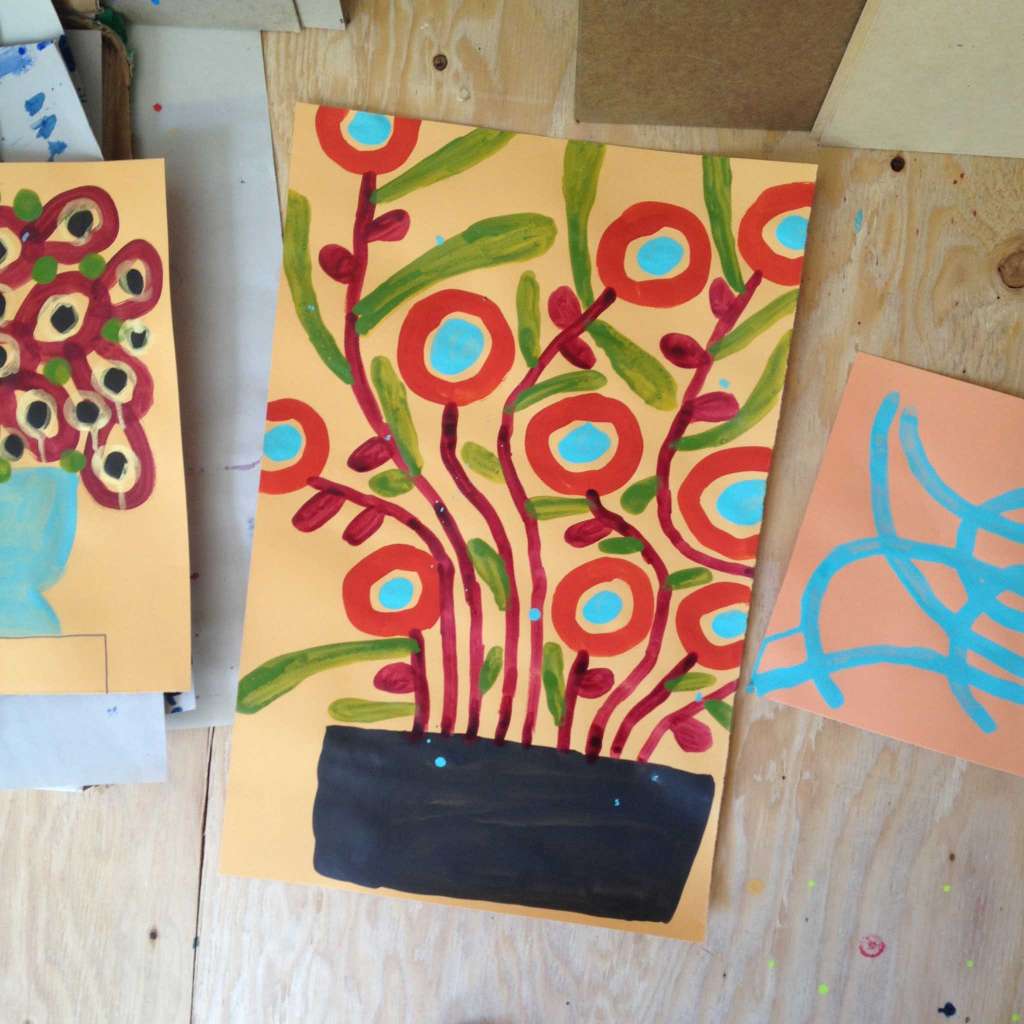
We are very pleased to have Tucker Nichols up on the walls again since it's been almost 4 years! In conjunction with the new exhibition, we have created a catalog which can be viewed here. Please direct all inquiries about pricing and availability to Hadley@gallery16.com.
Below is the official press release for Tucker Nichols current show, New Paintings, which is on view through March 6th:
Gallery 16 is pleased to present a show of new paintings by Bay Area artist Tucker Nichols, his fifth solo exhibition with the gallery. The exhibition is made up of more than 30 paintings and framed drawings, mostly of vases with flowers, a long-favored subject for the artist. “Flowers are a near perfect subject for a painting,” Nichols says. “They offer a bit of content but they can really look like anything. They’ve also been used as a stand in for inexpressible ideas since humans first started talking.” The new paintings explore more abstracted forms as well, in some cases resembling smokestacks or disheveled cakes.
Earlier this year, Nichols began making small flower paintings on paper to send by mail to sick friends. These evolved into a permanent commission of 40 framed works at the new UCSF Hospital at Mission Bay opening in February. This fall he began making the larger paintings for this exhibition “for people too busy to take care of real plants.”
Unlike previous installations in which Nichols combined many works into larger pieces, this show is composed exclusively of stand-alone paintings and drawings. “I like playing with context and location in installations, but it’s good to make things that can live on their own too,” Nichols says. “These paintings don’t need anything, not even water.”
After several years in the Marin Headlands, Nichols recently moved his studio to a former campaign headquarters above a tuxedo rental shop in downtown San Rafael. His work has been featured at the Drawing Center in New York, the San Francisco Museum of Modern Art, the Denver Art Museum, Den Frie Museum in Copenhagen, and the Asian Art Museum in San Francisco.
His drawings have been published in McSweeney's, The Thing Quarterly, Nieves Books and the Op-Ed pages of The New York Times.
Reed Anderson: HOUSE OF YES reviewed by Square Cylinder
December 29, 2014
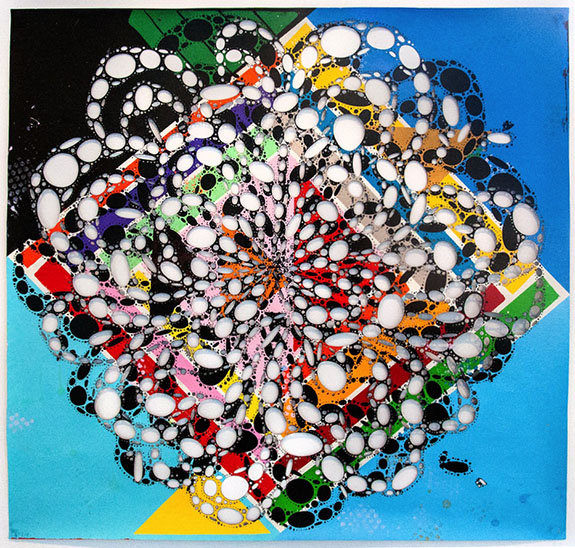
Reed Anderson: HOUSE OF YES reviewed by Square Cylinder
Merriam-Webster’s Collegiate Dictionary, 11th edition, defines “yes” as a function word. Meaning, one that establishes grammatical relationships between words, rather than content. Thus, if function is a form of process, then Reed Anderson’s work is the acme of yes. It consists of two resplendent bodies of work that appear under the title House of Yes. They showcase Anderson’s interest in embodied forms of production, using his hand to cut, paint, fold and layer stunningly beautiful works on paper. His work is very much part of the expanding practice of artisanal concerns evident in such museum shows as Labour and Wait at the Santa Barbara Museum of Art in 2013 and Fiber: Sculpture 1960-Present, currently at the ICA/Boston.
The rich materiality of Anderson’s work on paper accrues its presence through an accumulation of acts. After screen or woodblock printing sections of mostly primary colors, he cuts out hundreds of circular openings ranging in size from the head of a pin, to a standard hold punch, to the top of a soup can. He then folds and repaints or stamps pigment through the holes, allowing the blots and Baechleresque squishes to remain.
Given Anderson’s skilled use of line, edge, shape, and color it’s obvious he has formal facility. But in permitting “mistakes” to remain, he builds up a history and creates pentimento, giving his work an undeniable visceral charge. This also suggests that he doesn’t want to know what his next move or line will be and that he embeds himself within the making of the work.
Anderson draws upon a variety of sources. One body of work uses floral imagery to suggest bouquets or mandalas or muddied pieces ofscherenschnitte, the Swiss folk art of paper cutting. I am also reminded of the late cut paper paintings of Irene Pijoan (1954-2004) who taught at the San Francisco Art Institute, and where Anderson received his undergraduate degree. Like Pijoan, Anderson offers generosity and respect for the power of formal craft. The flower pieces are unbridled odes to beauty and the ceremonial rituals of birth, death and achievement.
Another group of work, from Anderson’s ongoing project The Papa Object, is based on images appropriated from fine art and furniture auction catalogues. Anderson grew up with art and antiquities in his family home. But rather than reject the materialism of these objects, he uses them as a springboard for layered works that refer to African textiles, Russian Constructivism, Modernism and decorative arts. There is also a performative component to this work. Some of it has been installed in private homes, offices, and even a research vessel in Antarctica, for the express purpose of being photographed in place. These multiple references, along with Anderson’s reproduction of reproductions, create emblems for endless scenarios about art, craft, commerce, trade, decoration, culture and history.
–JULIA COUZENS
Reed Anderson: House of Yes @ Gallery 16 through December 31, 2014.